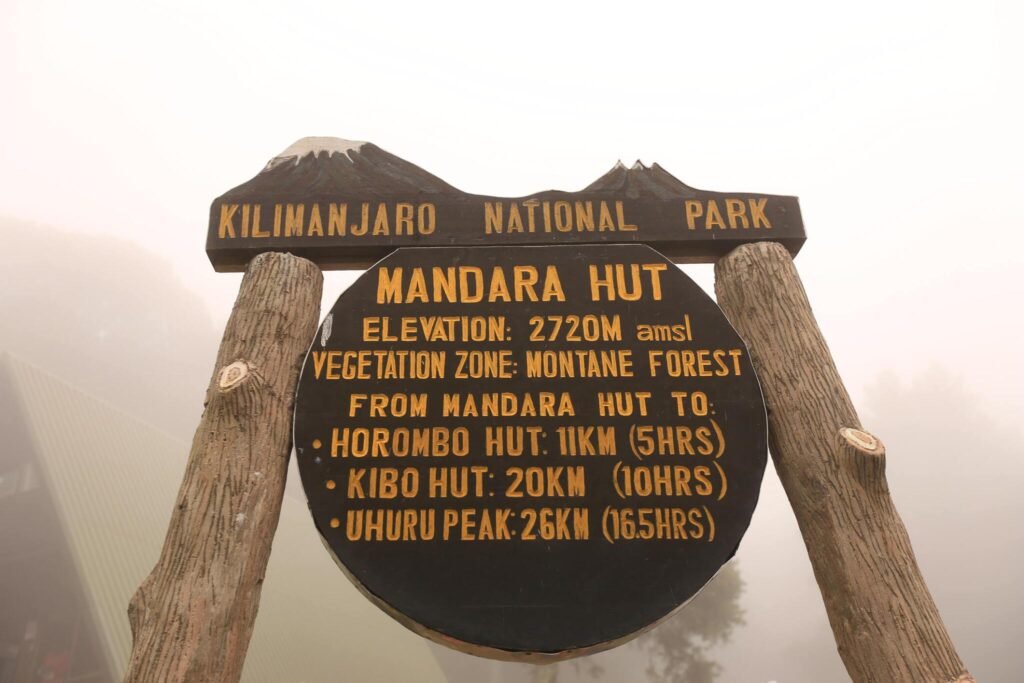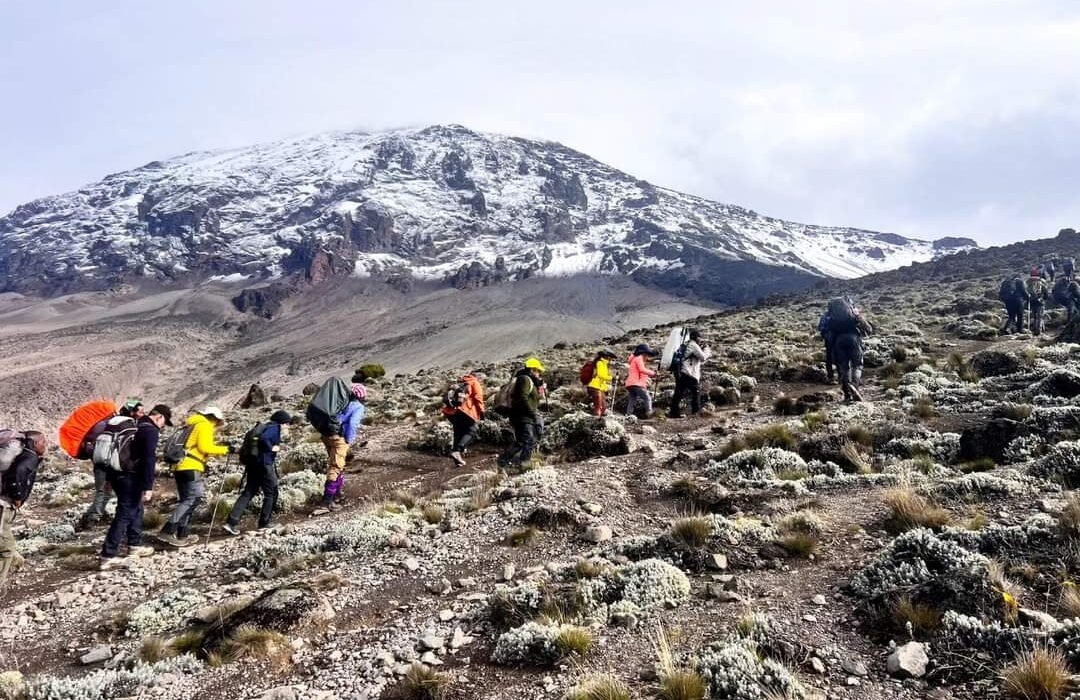10 Best Places for Photography on Mount Kilimanjaro. Mount Kilimanjaro is one of the most breathtaking places in the world for photography. As Africa’s highest peak, it offers diverse landscapes, dramatic vistas, and wildlife opportunities that make it a dream for adventurers and photographers alike. In this guide, we will explore 10 of the best locations to capture stunning photos while trekking up Kilimanjaro.
Plan your Kilimanjaro climb with expert guidance here.

10 Best Places for Photography on Mount Kilimanjaro : Mandara Huts (2,720 meters)
Located on the Marangu Route, Mandara Huts are one of the first stops for climbers ascending Kilimanjaro. The lush rainforests surrounding the huts provide a beautiful setting for nature photography. Early in the trek, you’ll have the opportunity to capture towering trees, unique flora, and possibly glimpses of wildlife like blue monkeys.
- What to Capture: Forest landscapes, vibrant greenery, and wildlife.
- Tip: Use a wide-angle lens to capture the dense forest canopy.
Learn more about Tanzania’s rainforest ecosystems here.

10 Best Places for Photography on Mount Kilimanjaro : Maundi Crater
Just a short detour from Mandara Huts, Maundi Crater offers panoramic views of the surrounding landscape. This ancient volcanic crater is a fantastic spot to photograph sweeping vistas, including views of Kenya’s lowlands on a clear day.
- What to Capture: Panoramic landscapes, crater views, distant mountains.
- Tip: Visit early in the morning for the best light and fewer clouds.
Explore more about volcanic craters and their formations.
10 Best Places for Photography on Mount Kilimanjaro : Shira Plateau (3,850 meters)
Shira Plateau is one of the most dramatic and open landscapes on Kilimanjaro. Located on the Lemosho Route, this expansive plateau offers stunning views of the mountain’s western side and the Kibo summit in the distance. The plateau is also known for its unique plant life, such as the giant groundsel and lobelia plants.
- What to Capture: Wide-open landscapes, Kilimanjaro’s summit in the distance, unique vegetation.
- Tip: Use a telephoto lens to zoom in on Kilimanjaro’s snow-capped peak.
Discover more about Kilimanjaro’s plant life.
10 Best Places for Photography on Mount Kilimanjaro : Lava Tower (4,600 meters)
At an altitude of 4,600 meters, Lava Tower is one of the most striking geological features on the mountain. This massive rock formation, which rises dramatically from the alpine desert, is a must-photograph spot for any climber. The contrast between the barren landscape and the towering rock provides a unique photo opportunity.
- What to Capture: Geological formations, contrasting landscapes, high-altitude desert.
- Tip: Photograph the Lava Tower during sunset for warm, golden hues.
Learn more about volcanic formations like Lava Tower.
10 Best Places for Photography on Mount Kilimanjaro : Barranco Wall (4,200 meters)
Barranco Wall is a steep, rocky ascent that challenges climbers both physically and mentally. However, the views from the top are well worth the effort. From the wall, you can capture sweeping views of the Barranco Valley and the surrounding peaks. The dramatic landscape, combined with the challenge of the climb, makes for some of the best photo opportunities on the mountain.
- What to Capture: Views of Barranco Valley, dramatic rock formations.
- Tip: Capture climbers ascending the wall for action shots and scale.
Explore more about the geography of Kilimanjaro’s Barranco Valley.
10 Best Places for Photography on Mount Kilimanjaro : Karanga Valley (4,000 meters)
Located between Barranco and Barafu Camps, Karanga Valley offers a peaceful landscape with a more gradual terrain. This area is perfect for photographing the sweeping slopes of Kilimanjaro, along with its unique cloud formations that often roll in during the afternoon.
- What to Capture: Cloud formations, rolling hills, and the silhouette of Kilimanjaro.
- Tip: Morning light in Karanga Valley offers softer shadows and more vibrant colors.
Learn more about weather patterns on Kilimanjaro.
10 Best Places for Photography on Mount Kilimanjaro : Barafu Camp (4,673 meters)
Barafu Camp is the final stop for most climbers before attempting the summit. From here, you can take some of the most stunning shots of the upper reaches of Kilimanjaro. The desolate, rocky landscape contrasts sharply with the snow-capped summit, creating a striking backdrop for photography.
- What to Capture: Summit views, rugged terrain, sunrise and sunset colors.
- Tip: Set up early for sunrise shots with the summit in the background.
Find out more about Barafu Camp and its importance.
10 Best Places for Photography on Mount Kilimanjaro : Stella Point (5,756 meters)
Reaching Stella Point is a major achievement for climbers, offering spectacular views of the crater and the final ascent to Uhuru Peak. The sweeping views and the proximity to the summit make this one of the most rewarding photo spots on the mountain.
- What to Capture: Views of the crater, summit approach, and climbers nearing the peak.
- Tip: Use a polarizing filter to reduce glare from the snow and enhance color contrasts.
Learn more about high-altitude photography.
10 Best Places for Photography on Mount Kilimanjaro : Uhuru Peak (5,895 meters)
The highest point in Africa, Uhuru Peak offers the ultimate reward for climbers and photographers alike. Here, you can capture the iconic summit sign, with sweeping views of the surrounding glaciers, crater, and distant plains below. This is the perfect spot to take your victory shot.
- What to Capture: Summit sign, glaciers, panoramic views.
- Tip: Arrive at Uhuru Peak early in the morning for the best lighting and minimal crowds.
Learn more about photography tips at Kilimanjaro’s summit.
10 Best Places for Photography on Mount Kilimanjaro : Kilimanjaro’s Glaciers
Although rapidly shrinking due to climate change, the glaciers near the summit of Kilimanjaro offer some of the most dramatic and surreal photo opportunities. These massive ice formations are a stark reminder of the mountain’s unique environment, and they provide a stunning contrast against the volcanic rock and sky.
- What to Capture: Glaciers, ice formations, and the dramatic contrast with the rocky terrain.
- Tip: Use a wide-angle lens to capture the vastness of the glaciers and the surrounding landscape.
Learn more about Kilimanjaro’s glaciers and climate change.
10 Best Places for Photography on Mount Kilimanjaro : Conclusion
Mount Kilimanjaro offers some of the most spectacular photography opportunities in the world. From lush rainforests to icy glaciers, every part of the trek is a photographer’s dream. Whether you’re a professional or just enjoy taking photos, these 10 spots will give you breathtaking images that capture the spirit and beauty of Kilimanjaro.
For more information on planning your Kilimanjaro climb and photography adventure, visit Kilimanjaro Climb Specialist or Eddy Tours & Safaris.

